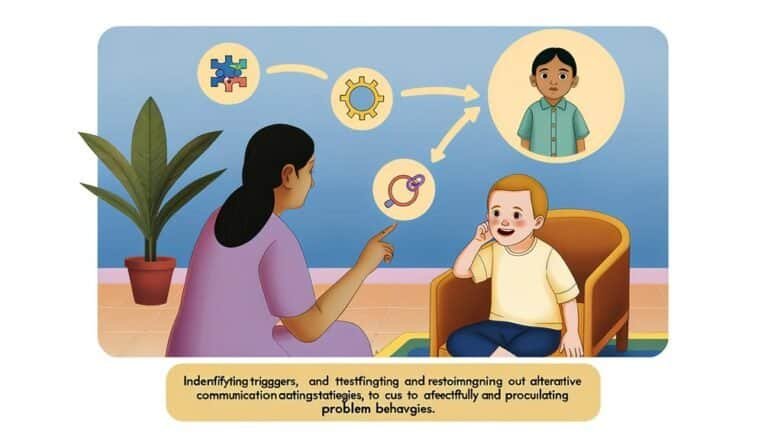Leveraging Educational Technology for Effective Training
In today's rapidly evolving workplace landscape, the integration of educational technology has become paramount in enhancing training programs. The utilization of innovative tools and platforms has revolutionized the way individuals acquire knowledge and skills. From interactive online courses to personalized learning experiences, the possibilities seem endless.
However, what truly sets effective training apart is the strategic implementation of these educational technologies. By combining data-driven strategies with collaborative learning platforms, organizations can access a world of potential for enhancing employee development and performance.
Key Takeaways
- Personalized learning experiences improve training outcomes and satisfaction levels.
- Interactive learning tools offer tailored feedback and practical applications for better learning.
- Immersive experiences enhance retention and engagement through dynamic training approaches.
- Enhanced training strategies with technology cater to individual needs and promote effective learning.
Benefits of Educational Technology
In the domain of modern learning, the integration of educational technology offers a myriad of advantages that enhance training effectiveness and engagement. One of the key benefits is the improved retention rates and increased knowledge transfer that result from interactive digital tools and platforms. Educational technology allows for personalized learning experiences, catering to individual learning styles and paces, which greatly boosts information retention and the application of newly acquired knowledge.
Moreover, the utilization of educational technology leads to enhanced learner satisfaction and improved training outcomes. By incorporating multimedia elements, simulations, and gamification, learners are more engaged and motivated to participate actively in their learning process. This high level of engagement not only increases satisfaction levels but also ensures that training objectives are met more effectively.
Interactive Online Courses
Enhancing the learning experience through interactive online courses revolutionizes traditional training methods by fostering dynamic engagement and personalized learning opportunities. Interactive assessments offer learners immediate feedback, allowing them to gauge their understanding and progress effectively. Adaptive feedback goes a step further by tailoring the learning experience based on individual strengths and weaknesses, ensuring a more personalized and effective learning journey.
Virtual labs provide a simulated environment where learners can apply theoretical knowledge in practical scenarios, enhancing their understanding and skills through hands-on practice.
Collaborative projects within online courses encourage teamwork and communication skills development, preparing learners for real-world workplace interactions and challenges.
Gamified elements like leaderboards, badges, and rewards make the learning process fun and engaging, motivating learners to stay active and committed throughout the course.
Virtual Reality Simulations
Virtual Reality Simulations offer a gateway to immersive learning experiences that transcend traditional training methods.
By engaging in interactive scenario simulations, learners can actively participate and make decisions in a controlled yet realistic environment.
This technology allows for the practical application of real-world skills, enhancing retention and mastery of knowledge.
Immersive Learning Experiences
Utilizing cutting-edge technology, immersive learning experiences offer a dynamic and interactive approach to training that engages learners on a deeper level. These experiences provide a simulated environment where learners can actively participate, enhancing their understanding and retention of information.
Through virtual field trips, individuals can explore far-off locations and historical sites without leaving the classroom. 360-degree simulations enable learners to immerse themselves in realistic scenarios, allowing for practical application and skill development in a controlled setting.
Interactive quizzes and challenges within these experiences keep learners engaged and motivated, fostering a more enjoyable learning process. Overall, immersive learning experiences revolutionize traditional training methods by providing a hands-on and fascinating educational journey.
Interactive Scenario Simulations
Immersive Scenario Simulations, particularly within the realm of Virtual Reality, have emerged as a pivotal tool in modern educational technology, elevating training experiences to new heights of interactivity and engagement. These simulations offer immersive learning environments where learners can engage with scenario-based challenges and make interactive decisions.
By incorporating role-playing simulations, users can apply theoretical knowledge in practical contexts, enhancing retention and understanding. This approach enables learners to experience real-world situations in a safe and controlled environment, fostering critical thinking and problem-solving skills.
Interactive scenario simulations provide a dynamic and engaging way to practice decision-making skills, allowing learners to explore different outcomes based on their choices. Essentially, these simulations bridge the gap between theory and practice, making learning more interactive and effective.
Real-World Skill Application
In the domain of educational technology, Real-World Skill Application through advanced Virtual Reality Simulations has revolutionized the way learners engage with practical scenarios. Virtual Reality (VR) simulations now play a vital role in facilitating skill mastery and practical application.
Here are three ways in which VR simulations enhance real-world skill application:
- Immersive Experiences: VR simulations provide an immersive environment where learners can apply theoretical knowledge to real-life situations, enhancing practical skills.
- Immediate Feedback: Learners receive instant feedback within the virtual environment, allowing for quick reflection and improvement of their practical abilities.
- Interactive Scenarios: VR simulations offer interactive scenarios that closely mimic real-world challenges, enabling learners to practice and perfect their skills in a safe and controlled setting.
Gamification in Training
Gamification in training offers a dynamic approach to enhancing learner engagement by integrating game elements into educational content. By motivating participants through rewards and recognition, training programs can effectively boost motivation and participation levels.
Additionally, fostering healthy competition among learners can create a stimulating environment that encourages active learning and skill development.
Enhancing Learner Engagement
To create a dynamic and interactive learning experience that captivates learners and promotes active participation, incorporating gamification strategies in training programs has emerged as a powerful tool for enhancing learner engagement.
Gamification enhances engagement through:
- Active Participation: By integrating interactive elements like quizzes, challenges, and leaderboards, learners are motivated to actively engage with the training content.
- Immediate Feedback: Providing personalized feedback on performance allows learners to track their progress in real-time, increasing their motivation to continue learning.
- Progress Tracking: Incorporating progress bars or badges helps learners visualize their advancement, creating a sense of accomplishment and encouraging further participation.
These strategies foster a more engaging and immersive learning environment, ultimately leading to improved training outcomes.
Motivating Through Rewards
Enhancing learner engagement through interactive elements like quizzes and challenges sets the stage for exploring the motivational impact of rewards in gamification strategies within training programs.
Incentive structures play an important role in motivating learners to actively participate and excel in their training. By incorporating rewards such as badges, points, or virtual trophies, training programs can tap into individuals' intrinsic motivation, driving them to achieve their learning goals. These motivation techniques not only make the training experience more enjoyable but also encourage continuous progress and achievement.
Additionally, rewards can create a sense of accomplishment, boosting learners' self-esteem and confidence. When designed effectively, incentive structures can greatly enhance learner motivation and overall training effectiveness.
Fostering Healthy Competition
Fostering healthy competition within training programs can substantially enhance learner engagement and motivation. By incorporating elements of gamification, such as team challenges and leaderboards, organizations can create an environment that drives individuals to excel.
Peer feedback becomes a valuable tool in this setting, allowing participants to learn from each other's strengths and areas for improvement. Performance metrics play a vital role in tracking progress and providing tangible goals for individuals to work towards.
This combination of elements not only makes the training experience more interactive and enjoyable but also instills a sense of accomplishment and pride in participants as they work towards achieving their learning objectives.
Personalized Learning Experiences
In the domain of educational technology, the implementation of personalized learning experiences revolutionizes traditional training methods by tailoring educational content to individual learners' needs and preferences. Adaptive instruction plays a critical role in this approach, as it enables the customization of learning pathways based on learners' performance and understanding levels. By providing tailored content, educational technology guarantees that learners receive materials that are relevant to their current knowledge and skill levels, fostering a more engaging and effective learning experience.
Personalized learning experiences also promote self-directed learning, empowering individuals to take control of their educational journey. Learners can progress at their own pace, explore deeper into topics of interest, and receive additional support in areas where they may be struggling. This individualized approach not only enhances knowledge retention but also boosts learners' confidence and motivation.
Additionally, personalized learning experiences can accommodate diverse learning styles and preferences, making education more inclusive and accessible to a wider range of learners. By catering to individual needs, educational technology creates a supportive and enriching environment that maximizes learning outcomes.
Mobile Learning Solutions
Mobile learning solutions offer the flexibility of accessing training materials on-the-go, enabling learners to engage with interactive multimedia content anytime, anywhere. This approach enhances the learning experience by providing real-time performance tracking, allowing for immediate feedback and personalized learning paths.
Incorporating mobile solutions into training programs can greatly enhance engagement, knowledge retention, and overall training effectiveness.
Access On-The-Go Learning
Amid the fast-paced nature of modern life, the demand for accessible and convenient learning solutions has propelled the significance of on-the-go learning through mobile technology. Mobile learning offers flexibility and accessibility, enabling learners to engage anytime, anywhere.
Its benefits include personalized learning experiences tailored to individual preferences and progress tracking for continuous improvement. Mobile devices provide a portable platform for interactive learning, incorporating multimedia elements for enhanced engagement. This mode of learning accommodates diverse learning styles, making education more inclusive and engaging.
With on-the-go accessibility, learners can seamlessly integrate learning into their daily routines, maximizing productivity and knowledge retention. Mobile learning solutions bridge the gap between traditional classroom settings and the dynamic digital landscape, offering a versatile and efficient educational experience.
Interactive Multimedia Content
Enhancing educational experiences through interactive multimedia content is a pivotal aspect of modern mobile learning solutions. Interactive storytelling and engaging simulations are key elements that make learning more immersive and effective. By integrating interactive multimedia content into mobile learning, learners can actively participate in the educational process, leading to better retention and understanding of the material.
| Benefits of Interactive Multimedia Content |
|---|
| 1. Enhances Engagement |
| 2. Facilitates Active Learning |
| 3. Improves Retention |
| 4. Fosters Critical Thinking |
| 5. Encourages Creativity |
Real-Time Performance Tracking
Real-time performance tracking in educational technology plays an important role in monitoring and evaluating learners' progress and engagement levels during mobile learning experiences. This feature enables educators to provide real-time feedback and implement adaptive training strategies to enhance the learning process effectively.
Key elements of real-time performance tracking in mobile learning solutions include:
- Progress tracking: Constantly monitoring learners' advancement and achievements.
- Performance analysis: Evaluating the effectiveness of training methods and identifying areas for improvement.
- Real-time feedback: Providing immediate comments and corrections to guide learners in the right direction.
Data-Driven Training Strategies
Utilizing data-driven training strategies is essential in modern educational technology for maximizing learning outcomes and performance improvement. Through thorough data analysis, educators can gain valuable insights into the effectiveness of their training programs. By collecting and analyzing data on learner progress, engagement levels, and assessment results, instructors can identify areas for improvement and tailor their teaching methods to better meet the needs of individual learners.
Data-driven training strategies also enable educators to track the overall training effectiveness by measuring key performance indicators and learning outcomes. This data can help in identifying trends, patterns, and areas of strength or weakness within the training program. By harnessing the power of data analysis, trainers can make informed decisions on where to allocate resources, which teaching methods are most successful, and how to continuously enhance the learning experience for all participants.
Augmented Reality Applications
Incorporating augmented reality applications into educational technology enhances the interactive learning experience by providing immersive and dynamic visualizations for learners. Augmented reality offers a unique way to engage learners through interactive simulations and hands-on learning experiences.
Here are three key ways in which augmented reality can revolutionize educational training:
- Immersive Simulations: Augmented reality allows learners to immerse themselves in realistic scenarios that simulate real-world environments, enabling them to practice and apply their knowledge in a practical setting.
- Hands-On Learning: By interacting with virtual objects in a 3D space, learners can engage in hands-on learning activities that promote active participation and deeper understanding of complex concepts.
- Experiential Training: Augmented reality provides practical applications for experiential training, allowing learners to gain valuable experience through interactive modules that simulate on-the-job situations. This hands-on approach enhances retention and skill development in a way that traditional training methods cannot replicate.
Collaborative Learning Platforms
Collaborative learning platforms have become indispensable tools in modern educational technology, facilitating interactive and engaging environments for learners to collaborate and exchange knowledge. These platforms enable group collaboration, fostering project-based learning where students can work together on assignments, share ideas, and solve problems collectively. Through group collaboration, students can develop essential teamwork and communication skills crucial for their future careers.
Additionally, collaborative learning platforms offer opportunities for peer feedback, allowing students to provide constructive criticism, support, and encouragement to their classmates. This process not only enhances the quality of work but also promotes a sense of community and shared learning goals within the classroom.
In addition, these platforms encourage reflective practice, where students can critically analyze their own learning processes, identify areas for improvement, and set personal learning objectives. By engaging in reflective practice, learners become more self-aware and proactive in their educational journey, leading to enhanced academic performance and personal growth.
Continuous Learning Opportunities
In the domain of educational technology, the evolution from collaborative learning platforms leads to a new horizon of continuous learning opportunities. As the landscape shifts towards more personalized and engaging learning experiences, the integration of microlearning techniques and adaptive learning platforms plays a pivotal role in shaping the future of education.
- Microlearning Techniques: By breaking down complex topics into smaller, bite-sized chunks, learners can engage in short, focused learning sessions that promote better retention and understanding of the material.
- Adaptive Learning Platforms: These platforms utilize data-driven insights to tailor learning experiences to individual needs, allowing learners to progress at their own pace and focus on areas where they need the most improvement.
- Personalized Feedback Mechanisms: Continuous learning opportunities are enhanced through personalized feedback mechanisms that provide learners with real-time assessments and recommendations for further study, creating a dynamic and responsive learning environment.
Conclusion
To sum up, the use of educational technology in training offers a plethora of benefits such as interactive online courses, virtual reality simulations, and personalized learning experiences. By leveraging data-driven strategies and collaborative platforms, organizations can provide continuous learning opportunities for their employees.
The possibilities are endless when it comes to incorporating technology into training programs, and the sky's the limit for those who embrace these innovative approaches. As the saying goes, 'the early bird catches the worm' – those who invest in educational technology will reap the rewards of effective training.







